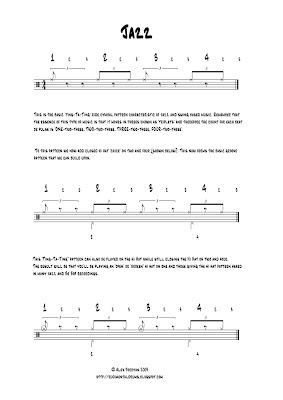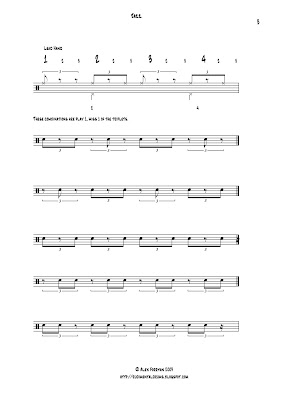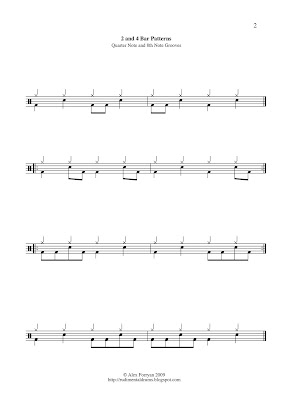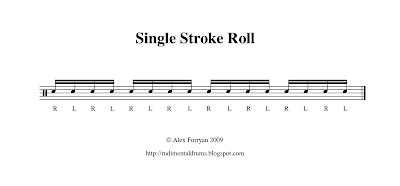6 Weeks already! Again apologies for not posting up everything from last week, I'll try to cover everything in this post but if anything gets left out do let me know.
Firstly, 16th note triplets and 16th note triplet shuffle. With regular 16th notes, we would sub-divide each quarter note pulse into 4 beats and count it 1-E-and-a, 2-E-and-a etc. With 16th note triplets we are dividing each beat into 6 even beats with a count of
1-2-3-4-5-6, 2-2-3-4-5-6 etc. To play a shuffle but in 16th note triplet form we would play the pattern like this :- (
Bold = notes to be played)
1-2-3-4-5-6 2-2-3-4-5-6 3-2-3-4-5-6 4-2-3-4-5-6
The best exponent of this style of playing is a drummer called Bernard Purdie. He has worked with many recording artists such as Aretha Franklin and Steely Dan. His version of this groove is now well known as the 'Purdie Shuffle' which incorporates 'ghost' notes played on the snare drum with your following hand (example below) as well as a back beat. This can be heard on 'Home at Last' and 'Babylon Sisters' by Steely Dan. This idea was taken even further by another drummer called Jeff Porcaro who often played this groove pattern over 2 bars incorporating a 'clave' pattern on the bass drum - examples of this groove can be found on 'Rosanna' by Toto and 'Any Foolish Thing' by Micheal MacDonald.
An example of this groove can be found at the bottom of this post.
Work through the sheets below at your own pace and if you can have a listen to a few examples.
Our second subject was 8th and 16th note grooves played one-handed and hand-to-hand on the hi hat - with 8th and 16th notes on the bass drum.
The first pattern we played was the 1 and-a, 2 and-a, 3 and-a, 4 and-a, on the hi hat with on hand as show
here or hand-to-hand as shown
here.
The second pattern was 1-E-and, 2-E-and, etc on the hi hat again played with one hand as shown
here or hand-to-hand as shown
here.
The third pattern (the one you didn't like!) was playing 1-E a, 2-E a, 3-E a, 4-E a on the hi hat with one hand as shown
here and hand-to-hand as shown as
here.
The Purdie Shuffle :-
























